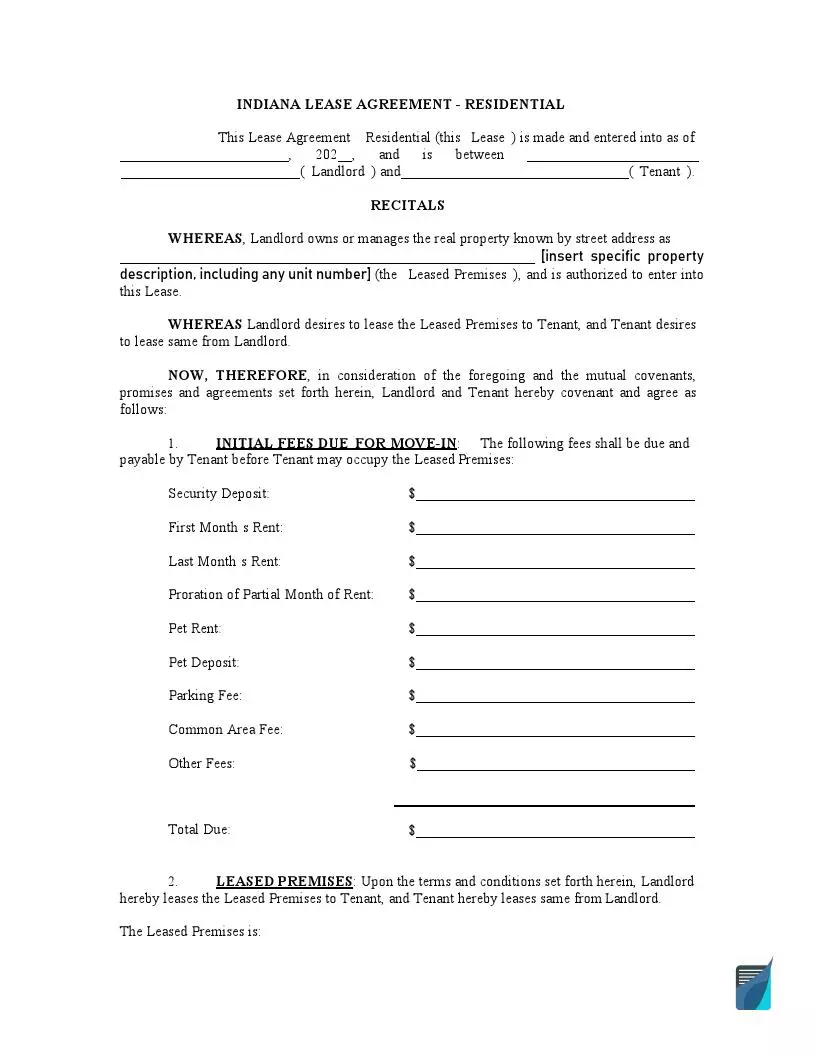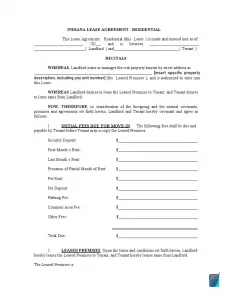Indiana Rental Lease Agreement Forms
If you are interested in rent or lease in the state of Indiana, take a few minutes to look through this piece. Before getting into a binding obligation, it’s good to get acquainted with local rental norms and regulations. A legal relation between a tenant and a landlord in the state is regulated by the Indiana Code (Article 31). Make sure to check out the newest version of the Code on the Indiana government official website.

Build Your Document
Answer a few simple questions to make your document in minutes
Save and Print
Save progress and finish on any device, download and print anytime
Sign and Use
Your valid, lawyer-approved document is ready
Indiana Laws and Lease Requirements
There are several categories of a lease agreement form in Indiana. According to the local laws, parties can agree on a month-to-month tenancy, a year-to-year tenancy, or a tenancy with a determined term (not less than three months).
A tenancy cannot arise without a contract, as stated by the Indiana Code. The basic principles and guidelines of a rental agreement compilation stay the same for all kinds of agreements. However, termination procedures differ. One should provide a three-month termination notice to end a year-to-year agreement and a 30-day notice to terminate a monthly agreement. A determined term tenancy ends upon its expiration date.
All arrangements made between the parties should be in a written form. Usually, the parties use a specific notice to inform each other on any matter related to the deal. The notice has to be signed and dated and delivered by first-class mail or in-person. One needs to take this measure to prove a point in case of a lawsuit against them.
Pay special attention to local environmental issues and peculiarities. Some territories are more vulnerable to natural disasters like forest fires and floods than others. Therefore, local authorities often make it obligatory for the landlords to take responsibility for property protection and repercussions.
Indiana Lease Agreement: How to Write
There is no standard lease agreement. You may use legal assistance or find a copy online. But for your safety and convenience, we suggest you use our software tools to build a lease agreement form.
A lease agreement should contain all the necessary details, including:
- names and other personal data of the tenant and the landlord;
- the subject premises’ description, including physical address;
- rent amount and its payment due date;
- security deposit amount and its returning policy details;
- the rights and obligations of both parties,
- legal fees and liability;
- disclosures (if applicable);
- agreement termination procedures,
- any other conditions that parties consider vital.
Below, we provide a brief review of the most sensitive and thus important parts of a lease agreement.
Security Deposit
A lease agreement has a section dedicated to the security deposit. It is a certain amount of money to cover any damages caused to the premises by the tenant or members of his family during residence. The tenant gets their security deposit back at the end of the tenancy, provided they kept the property in its initial condition and did not breach the agreement.
Popular Local Rental Lease Agreement Forms
Landlord’s Right to Entry
Under this article, the landlord obtains the right to enter the subject premises during working hours for inspection purposes. An inspection is not only required for the landlord to keep an eye on the tenant but to also make the necessary repairs and alterations to the property. The tenant, in turn, should agree to eliminate all obstacles for such an inspection.
Fees and Liability
The tenant should always read the lease agreement very carefully because, in case of a breach, they would become liable to the landlord. The landlord can file for cost reparation of such an action, including reasonable attorney’s fees cost.
If the tenant fails to pay the rent in time for any reason, the landlord can give them a 10-day Notice to Pay or Quit. During this term, the parties still have a good chance to come to an agreement.
Obligatory Disclosures
As mentioned before, local authorities tend to ask the landlords for cooperation in times of emergencies. For example, in Indiana, all agreements made or renewed after 30 June 2009 shall contain a flood plain disclosure if the lowest floor of the premises is below 100 annual frequency flood elevation. You can look at local flood plain maps provided by the Federal Emergency Management Agency before signing an agreement.
Provided you did your research and agreed on important details and matters, you shall be able to avoid any unpleasant situations in tenant-landlord relations.
Indiana Rental Lease Agreement Form Details
| Document Name | Indiana Rental Lease Agreement Form |
| Other Names | IN Rental Lease, Indiana Residential Lease Agreement |
| Relevant Laws | Indiana Code, Title 32, Article 31 |
| Security Deposit Amount | No limit |
| Security Deposit Return | Forty-five (45) days from termination date |
| Avg. Time to Fill Out | 18 minutes |
| # of Fillable Fields | 119 |
| Available Formats | Adobe PDF |


Other printable Indiana forms available for download here and that can be customized in our hassle-free document maker.
Other Rental Lease Agreement Forms by State
